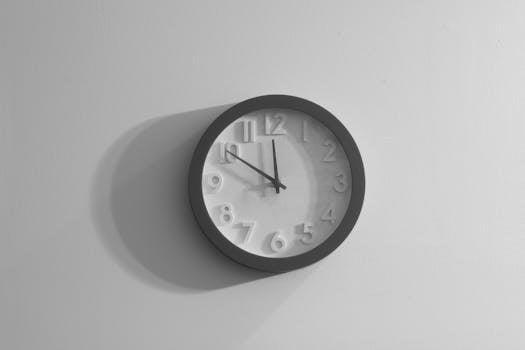
sharp atomic clock user manual
Sharp atomic clocks utilize radio signals to maintain precise time․ These clocks are known for their accuracy, often needing no manual adjustments․ They offer various models for both desktop and wall use, with some featuring additional functionalities․
Overview of Sharp Atomic Clock Technology
Sharp atomic clocks employ radio-controlled technology, specifically relying on the WWVB signal broadcast from Fort Collins, Colorado․ This signal provides an incredibly accurate time reference that the clock uses to synchronize itself automatically․ The core of this technology is the atomic clock, which uses the oscillations of atoms to measure time, ensuring it is accurate to within a second․ Sharp integrates this technology into various clock designs, from wall clocks to desktop models․ These clocks continuously monitor for the signal, and if reception is lost, they attempt to reacquire it automatically․ They are designed to be user-friendly, with features such as automatic time setting and adjustments for daylight saving time․ The system ensures that the time displayed is highly accurate and reliable with minimal maintenance required by the user․ This technology is what makes Sharp atomic clocks a popular choice for those needing precision timekeeping․
Importance of Accurate Timekeeping
Accurate timekeeping is crucial in numerous aspects of modern life, from coordinating daily schedules to synchronizing complex technological systems․ For many, having a reliable clock provides a sense of structure and helps ensure punctuality for appointments and meetings․ In a professional context, precise timing is essential in industries like finance, aviation, and telecommunications, where even slight discrepancies can have significant consequences․ Furthermore, accurate time is fundamental to many scientific experiments and research, as it allows for precise data collection and analysis․ Atomic clocks, like those from Sharp, are essential in these areas because they provide a dependable and consistent time source, eliminating the need for manual adjustments․ This reliability ensures that individuals and organizations can operate with the assurance of correct timekeeping, helping to maintain efficiency and avoid costly errors in both professional and personal life, hence underscoring the overall need for accurate timekeeping․

Identifying Your Sharp Atomic Clock Model
Locating your specific Sharp atomic clock model is crucial for accessing the correct manual․ Model numbers are typically found on the device itself, usually starting with “SPC” or “NLC”․
Locating the Model Number
To properly identify your Sharp atomic clock and access its specific instructions, it’s essential to locate the model number․ This crucial identifier is typically printed directly on the clock itself․ Carefully examine the back, bottom, or side of your device․ Look for a sequence of characters that often begins with the prefix “SPC” for Sharp-branded models, or “NLC” for Nelsonic devices․ The model number may be printed on a sticker or directly embossed onto the casing․ This alphanumeric string is vital for finding the correct user manual․ Once you have this information, you can easily find the corresponding instructions for your clock model․ It is important to double-check the number to ensure you have the exact match which will allow for accurate guidance for proper usage and maintenance․
Common Sharp Atomic Clock Model Prefixes (SPC, NLC)
When identifying a Sharp atomic clock, understanding the common model prefixes is crucial․ Primarily, Sharp-branded atomic clocks typically begin with the prefix “SPC,” followed by a series of numbers․ For example, model numbers might look like “SPC373” or “SPC900″․ This prefix indicates that the clock is manufactured by Sharp․ Alternatively, you might encounter clocks with the prefix “NLC,” which signifies that the clock is a Nelsonic product․ Nelsonic is often associated with similar products using atomic time technology․ Knowing these prefixes helps differentiate between different manufacturers and is vital for accessing the correct user manuals․ When searching for information, always note whether your model starts with SPC or NLC as this will lead you to the right resources for your specific clock․ Remember to also look for the complete model number for the most accurate results․

Initial Setup and Operation
Setting up your Sharp atomic clock begins with battery installation․ The clock automatically synchronizes using the WWVB signal․ Manual time setting options are also available for initial setup․
Battery Installation and Powering On
To begin, locate the battery compartment on the rear of your Sharp atomic clock․ Open the compartment, usually by sliding or using a small screwdriver․ Insert the correct type and number of batteries, typically AA or AAA, ensuring the polarity (+/-) matches the markings inside the compartment․ Once the batteries are correctly installed, close the compartment securely․ The clock should now power on․ You might see the display initially flashing, indicating that it is starting up and attempting to receive the WWVB radio signal․ Allow several minutes for the clock to establish its connection and set the time․ If the signal isn’t immediately received, it is advised to wait overnight, as the clock will continue its attempt in the background․ Avoid pressing any buttons during the initial signal search, unless you intend to manually set the time․
Automatic Time Synchronization with WWVB Signal
Sharp atomic clocks are designed to automatically synchronize with the WWVB radio signal broadcast from Fort Collins, Colorado․ This signal carries the precise time maintained by the US National Institute of Standards and Technology․ Upon powering on or after a battery change, your clock will start searching for this signal, often indicated by flashing digits on the display․ The clock will attempt to receive the signal periodically, ensuring accurate timekeeping․ The success of signal reception can depend on several factors including location, the orientation of the clock, and atmospheric conditions․ It is advisable to place the clock near a window or exterior wall for better signal reception․ If the clock does not receive the signal immediately, it is recommended to leave it overnight, as it will continue searching․ Once synchronized, the clock will display the correct time automatically, maintaining its accuracy to within one second․
Manual Time Setting Options
While Sharp atomic clocks are designed for automatic synchronization, they also provide manual time setting options․ This is particularly useful in areas with poor WWVB signal reception or when you need to set the time immediately․ Typically, manual setting involves using buttons on the clock labeled “SET,” “HOUR,” and “MINUTE․” Pressing the “SET” button usually puts the clock into manual setting mode, and then you can use the “HOUR” and “MINUTE” buttons to adjust the time․ Some models may have additional buttons for setting the year, month, and date․ It’s crucial to refer to your specific model’s instruction manual for precise button usage and sequence․ After manually setting the time, the clock will still attempt to synchronize with the WWVB signal periodically, but the manual time setting will remain until it successfully receives a signal․ This manual option allows for flexibility and guarantees you can always have the correct time displayed․

Advanced Features and Settings
Sharp atomic clocks often include features beyond basic timekeeping․ These may consist of alarms, temperature displays, and time zone settings․ These advanced settings enhance user experience and functionality․
Setting Alarms and Snooze Function
Sharp atomic clocks commonly provide alarm functionalities to assist with daily schedules․ Typically, setting an alarm involves pressing a dedicated ‘ALM’ or ‘SET’ button, followed by adjusting the desired hour and minute using arrow buttons․ Some models might feature separate buttons for setting the alarm and time․ Once set, the alarm will trigger at the designated time, and it will sound for a specific duration, usually around two minutes, before automatically shutting off․ A snooze function allows for a brief delay before the alarm sounds again, usually activated by pressing the ‘SNZ’ button․ Each press of the snooze button typically grants a short respite, often a few minutes, before the alarm reactivates․ These features enhance the clock’s utility as a daily wake-up tool․ The specific steps might vary slightly depending on your model, so always consult the manual for detailed instructions․
Understanding Temperature Display and Wireless Sensor
Many Sharp atomic clocks include the feature of displaying temperature, both indoors and outdoors․ The indoor temperature is usually measured by a sensor built into the clock itself, while the outdoor temperature relies on a wireless sensor․ This external sensor, powered by batteries, communicates with the clock to transmit the outdoor temperature reading․ The clock’s display will typically show both temperatures, often in degrees Fahrenheit or Celsius․ It’s crucial to place the wireless sensor in a location that is sheltered from direct sunlight and rain for accurate readings․ The range of the wireless sensor is often limited, so keeping it within the specified distance from the clock is important for proper functionality․ When the clock searches for an atomic signal, the weather station capabilities might be disabled temporarily․ Understanding this feature allows you to monitor environmental conditions around your home․
Using the Time Zone Settings
Sharp atomic clocks often provide time zone settings to adjust for different geographical locations․ This feature ensures accurate time display even when you are not in the same time zone as the WWVB signal transmitter․ The clock will have options to select the appropriate time zone, which will then shift the displayed time accordingly․ Typically, these settings can be accessed through the clock’s menu or by using specific buttons․ It’s important to choose the correct time zone for your region to avoid any time discrepancies․ Some models may automatically adjust for daylight saving time, while others require manual adjustment․ Understanding the time zone settings is necessary to ensure the clock shows the correct time․ Incorrect settings can lead to confusion and inaccurate time display․ Always check your manual for specific instructions on how to change the time zone settings for your particular Sharp model․

Maintenance and Troubleshooting
Maintaining your Sharp atomic clock involves regular cleaning and occasional battery replacement․ Troubleshooting signal reception and other issues is also covered to ensure optimal performance and longevity of the clock․
Care and Cleaning of your Atomic Clock
To ensure the longevity and accurate functioning of your Sharp atomic clock, regular care and cleaning are essential․ Begin by unplugging the clock or removing the batteries to prevent any electrical issues․ Gently wipe the clock’s exterior surfaces using a soft, dry cloth․ Avoid using abrasive cleaners or solvents, as these can damage the clock’s finish․ For stubborn smudges, lightly dampen the cloth with water, ensuring it is not overly wet․ Be particularly careful around the display screen to avoid scratches․ Do not submerge the clock in any liquid, and ensure that no moisture enters any openings․ Regular dusting will also help to maintain its appearance․ By following these simple steps, you can keep your Sharp atomic clock in excellent condition for years to come․
Troubleshooting Common Issues with Signal Reception
If your Sharp atomic clock is not receiving the WWVB signal, there are several troubleshooting steps you can take․ First, ensure that your clock is located in an area where the signal is not obstructed by walls, metal, or electronic devices․ Try positioning the clock near a window․ A manual signal search can be initiated by holding the relevant button for a few seconds․ If this doesn’t work, wait overnight, as the signal is often stronger during the early morning hours․ Check that the batteries are fresh and correctly installed․ Avoid placing the clock near devices that may cause interference, such as computers or microwaves․ Remember that weather conditions can also affect signal reception․ If problems persist, consult the user manual or the manufacturer’s website for further assistance․
Battery Replacement Procedures
When the battery in your Sharp atomic clock needs replacing, it’s essential to follow the correct procedure to ensure continued proper function․ First, locate the battery compartment, usually on the back of the clock․ Open the compartment using a small screwdriver or by sliding the cover, depending on your model․ Remove the old batteries and note their type, typically AA or AAA․ Insert the new batteries, ensuring correct polarity (+ and -) alignment․ Close the compartment securely․ After replacing the batteries, the clock will typically attempt to synchronize with the WWVB signal automatically․ If it doesn’t, a manual time search might be needed․ Remember to use only the specified battery type․ Dispose of old batteries properly, following local guidelines․ If you encounter difficulties, refer to your clock’s specific user manual․